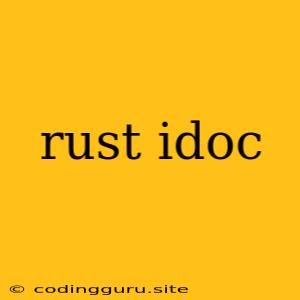What is rustdoc?
rustdoc is a powerful tool that comes built-in with the Rust compiler. It automatically generates documentation for your Rust code, making it easier for others (and your future self!) to understand and use your libraries and programs. rustdoc processes your code and comments to create a beautifully formatted website, complete with examples and cross-references.
Why Use rustdoc?
1. Improved Code Clarity: rustdoc helps you write better code by encouraging you to document your functions, types, and modules thoroughly. This process forces you to think about how your code is structured and how others might use it.
2. Easier Collaboration: When working on projects with others, clear documentation is essential. rustdoc helps ensure everyone on the team can understand the codebase, making collaboration smoother and reducing confusion.
3. Self-Documentation: rustdoc allows you to document your code in a way that is automatically integrated with your project. This means you don't have to maintain separate documentation files, making your workflow more efficient.
How to Use rustdoc
Let's dive into the basics of using rustdoc:
1. Add Documentation Comments:
The heart of rustdoc is the use of documentation comments. These comments are written with /// at the beginning of the line.
/// This is a function that adds two numbers together.
///
/// # Examples
///
/// ```rust
/// let sum = add(2, 3);
/// assert_eq!(sum, 5);
/// ```
fn add(x: i32, y: i32) -> i32 {
x + y
}
2. Run rustdoc:
You can use the command rustdoc in your terminal to generate documentation for your project. For example:
rustdoc src/main.rs
This will create an HTML directory containing the documentation.
3. Markdown Support:
rustdoc supports Markdown syntax within your documentation comments, allowing you to format text, create headings, and include code examples.
4. Using Attributes:
You can further enhance your documentation by using attributes. For instance, the #[doc = "..."] attribute lets you add documentation to items without using comments.
#[doc = "This is a function that adds two numbers together."]
fn add(x: i32, y: i32) -> i32 {
x + y
}
5. Customizing rustdoc:
You can customize the output of rustdoc through various flags. For instance, --open will open the generated documentation in your default browser.
Advanced rustdoc Features
1. External Documentation:
rustdoc can integrate with external documentation files, such as Markdown files, to create a comprehensive documentation set.
2. Cross-References:
rustdoc automatically creates hyperlinks between related items, making it easy to navigate and understand code relationships.
3. Documentation Tests:
You can write documentation tests to ensure your documentation stays up-to-date with code changes.
4. Code Examples:
rustdoc supports code examples within documentation comments. These examples are run and verified, ensuring their accuracy.
Tips for Writing Effective Documentation
- Be Concise and Clear: Write your documentation in a way that is easy to understand and follow.
- Use Examples: Illustrate your code with clear, working examples to demonstrate its usage.
- Link to Related Documentation: Use cross-references to connect different parts of your codebase.
- Keep Documentation Up-to-Date: Make sure your documentation is always updated to reflect any changes in your code.
Conclusion
rustdoc is a valuable tool for any Rust developer. It not only helps you document your code but also encourages you to write cleaner, more understandable code. By embracing rustdoc and following best practices, you can create robust and well-documented Rust projects that are easier to understand and maintain.
